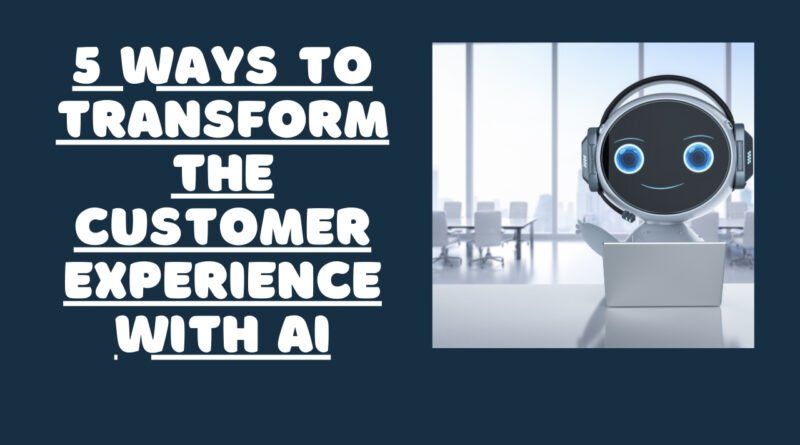5 Ways To Transform The Customer Experience With AI
In the rapidly evolving digital landscape, artificial intelligence (AI) has emerged as a game-changing force, offering unprecedented tools for crafting exceptional customer experiences. This technological revolution is particularly potent when implemented within a connected ecosystem, allowing businesses to harness the full potential of AI across their operations.
The C-Suite Perspective on AI
The significance of AI in today’s competitive business environment is not lost on top executives. A groundbreaking study conducted by IBM’s Institute for Business Value reveals a striking statistic: 75% of CEOs are convinced that future competitive advantage will hinge on the sophistication of an organization’s generative AI capabilities. This high-level endorsement of AI technology is driving a surge of interest and investment across industries.
Responding to this executive mandate, marketing and commerce leaders are scrambling to explore AI solutions, recognizing their potential to revolutionize customer interactions at every touchpoint of the buyer’s journey. The promise of AI extends beyond mere efficiency gains, offering the tantalizing prospect of enhanced organizational productivity coupled with innovative digital experiences that can transform customer engagement.
However, despite the buzz and enthusiasm, the journey towards full AI integration is still in its early stages for many organizations. The same study indicates that over 76% of senior executives are currently in the process of developing or planning their AI roadmaps, highlighting both the perceived importance of AI and the complexity involved in its implementation.
The Power of a Connected AI Ecosystem
While many marketing and commerce teams are already familiar with generative AI – which creates content based on patterns learned from training data – the full potential of AI extends far beyond content generation. Other forms of AI leverage machine learning algorithms and statistical models to analyze historical data and make predictive insights about customer behavior.
The true magic happens when these various AI tools are integrated within a unified, connected ecosystem. This synergy allows for a seamless flow of data and insights across different AI applications, magnifying their impacts and creating a whole that is greater than the sum of its parts.
For instance, imagine using AI to analyze customer engagement data and predict which types of creative content will resonate most strongly with your audience. These insights can then be fed directly into AI-powered content generation tools, creating a feedback loop that continuously refines and improves your marketing efforts. Alternatively, AI can be used to rapidly generate and test multiple content variations in real time, optimizing performance on the fly based on immediate audience responses.
Transforming the Customer Journey with Connected AI
A suite of interconnected AI tools that spans both marketing and commerce tech stacks has the potential to revolutionize every stage of the customer journey. Here’s how marketing teams can leverage this power:
AI empowers organizations to design and optimize marketing campaigns with unprecedented precision. By analyzing vast amounts of data, AI can identify patterns and trends that human marketers might miss, leading to more effective media planning and commerce strategies. This results in improved customer experiences and higher conversion rates.
AI’s ability to understand the impact of individual campaign elements – such as specific content assets or ad designs – on key success metrics like conversion rates and average order values is particularly valuable. This granular level of insight allows for the creation of highly personalized, multi-channel campaigns that are tailored to the preferences of individuals and specific market segments.
Moreover, AI enables marketers to adapt their content strategies in real time based on key engagement and sales metrics, ensuring that campaigns remain relevant and effective even as market conditions change.
Hyper-Personalizing Customer Experiences
In the realm of personalization, AI takes marketers and commerce teams beyond basic segmentation, enabling true one-to-one marketing at scale. Advanced AI tools can recommend tailored experiences based on individual customer profiles and preferences, which are continuously updated as customers interact with various touchpoints.
This level of personalization extends to content creation as well. AI can generate thousands of image and content variations, bringing personalized recommendations to life in a way that resonates with each customer.
Accelerating Content Creation
The content creation process is another area where AI shines. It allows marketing teams to develop insightful content roadmaps and then execute them at unprecedented speeds, producing the fresh, relevant content that today’s customers demand.
AI achieves this by analyzing historical engagement data for different types of content assets, identifying trends, and suggesting which types of content will be most effective at each stage of the customer journey. It then accelerates the entire content lifecycle, from ideation and copywriting to design reviews, approvals, and final delivery and activation.
Connecting and Orchestrating Customer Journeys
Creating seamless, cohesive customer journeys is a complex task that AI is uniquely suited to handle. The latest AI tools can analyze vast amounts of data to identify the most effective touchpoints and interactions for different market segments, helping marketers design customer journeys that feel effortless and natural.
When deployed in real-time, AI can guide customers through personalized journeys that increase engagement and conversion rates. Other AI capabilities can optimize the content and communications that power these journeys based on real-time engagement data, ensuring that each customer receives the most relevant and compelling experience possible.
Scaling Asset Variations for Rigorous Market Testing
A/B testing has long been a staple of digital marketing, but AI takes this concept to new heights. It enables marketers and commerce teams to test numerous content variations and experiences simultaneously, identifying the ones that customers are most likely to engage with.
AI can produce a vast array of content variations tailored to different audience segments and preferences. This ability to scale asset variations ensures that each customer receives a personalized experience, regardless of their specific needs or location. Furthermore, AI can determine which variations are most effective in real time, continuously refining the content strategy for optimal results.
Real-World Success Stories
The transformative power of AI in marketing and commerce is not just theoretical – many businesses are already seeing tangible results from leveraging AI tools across their tech stacks. Early adopters, particularly those using comprehensive platforms like Adobe’s martech stack (which incorporates both predictive AI models like Adobe Sensei and generative AI models like Adobe Firefly), are leading the way.
Take, for example, the iconic camera manufacturer Canon USA. By leveraging the predictive AI built into Adobe Commerce, Canon has revolutionized its approach to personalized customer journeys. Niche customers, such as professional night photographers or wedding photographers, can now quickly and easily find products tailored to their specific needs. The AI dynamically directs them to related products, accessories, and content that address their business needs, significantly increasing the likelihood of a purchase.
As Michael Lebron, senior director and head of front office applications at Canon, puts it: “It’s all about personalization — getting the customers to the content that’s most relevant to them, in their preferred channel.”
Another striking example comes from tech giant IBM, which recently harnessed Adobe Firefly’s generative AI capabilities to streamline its creative processes. By integrating generative AI directly into its workflows, IBM’s team was able to generate an astounding 200 assets and over 1,000 marketing variations in mere minutes – a process that would have traditionally taken days or even months. The results were equally impressive: the campaign achieved 26 times higher engagement than benchmarks and effectively reached high-value audiences, with 20% of respondents identified as C-level decision-makers.
The Importance of a Connected Martech Stack
While the potential of AI is clear, one of the biggest challenges in adopting this technology is that the tools best suited for a particular business or industry are not always part of a single platform.
Organizations running a collection of best-of-breed AI tools often find themselves building numerous custom connectors to integrate these disparate systems, especially if the chosen software doesn’t offer flexible APIs.
This is where platforms like Adobe’s martech and commerce stack shine. Adobe’s solution is designed to make combining AI tools easier in two key ways:
First, it’s fully integrated and comes with native AI models like Firefly and Sensei built-in. This allows businesses to get started with AI-powered workflows within familiar Adobe tools, reducing the learning curve and accelerating adoption.
As Patrick Toothaker, principal product marketing manager for digital experience at Adobe, explains: “Our tech stack encompasses both generative and predictive AI and allows a two-way flow of information between the two that accelerates results.
Second, Adobe’s platform is built to easily exchange data with other systems via well-documented APIs. The API Mesh for Adobe Developer App Builder allows businesses to connect their Adobe marketing solutions to Adobe Commerce, Customer Relationship Management (CRM) systems, Enterprise Resource Planning (ERP) software, Point of Sale (POS) systems, and other key business tools. Additionally, Adobe boasts an extensive network of technology partners that have developed pre-built integrations for virtually every Adobe solution, from commerce to marketing and beyond.
Embracing the AI-Powered Future
As we stand on the cusp of an AI-driven revolution in marketing and commerce, it’s clear that the future is now. A fully integrated, AI-powered ecosystem like Adobe’s can help businesses transform every stage of the customer journey. It provides deep insights into customer behavior, anticipates their needs, and empowers creative teams to quickly build personalized content that addresses those needs in real time.
By taking action now to incorporate AI into their workflows, marketing, and commerce teams can deliver exceptional customer experiences, maintain a competitive edge, and achieve significant operational efficiencies. The companies that move quickly to adopt and integrate AI technologies will be best positioned to thrive in this new era of data-driven, personalized marketing and commerce.
Working with companies like Adobe and its vast network of technology partners, which facilitate easy connection of AI-powered solutions via API, represents an excellent first step on this transformative journey. As AI continues to evolve and mature, we can expect to see even more innovative applications and use cases emerge, further revolutionizing the way businesses interact with their customers and manage their operations.
In conclusion, the AI revolution in marketing and commerce is not just coming – it’s already here. The organizations that recognize this shift and act decisively to harness the power of AI will be the ones that lead their industries into this exciting new era of customer engagement and business optimization. The future of marketing and commerce is AI-driven, personalized, and more efficient than ever before – and it’s time for businesses to embrace this change and ride the wave of innovation to new heights of success.

